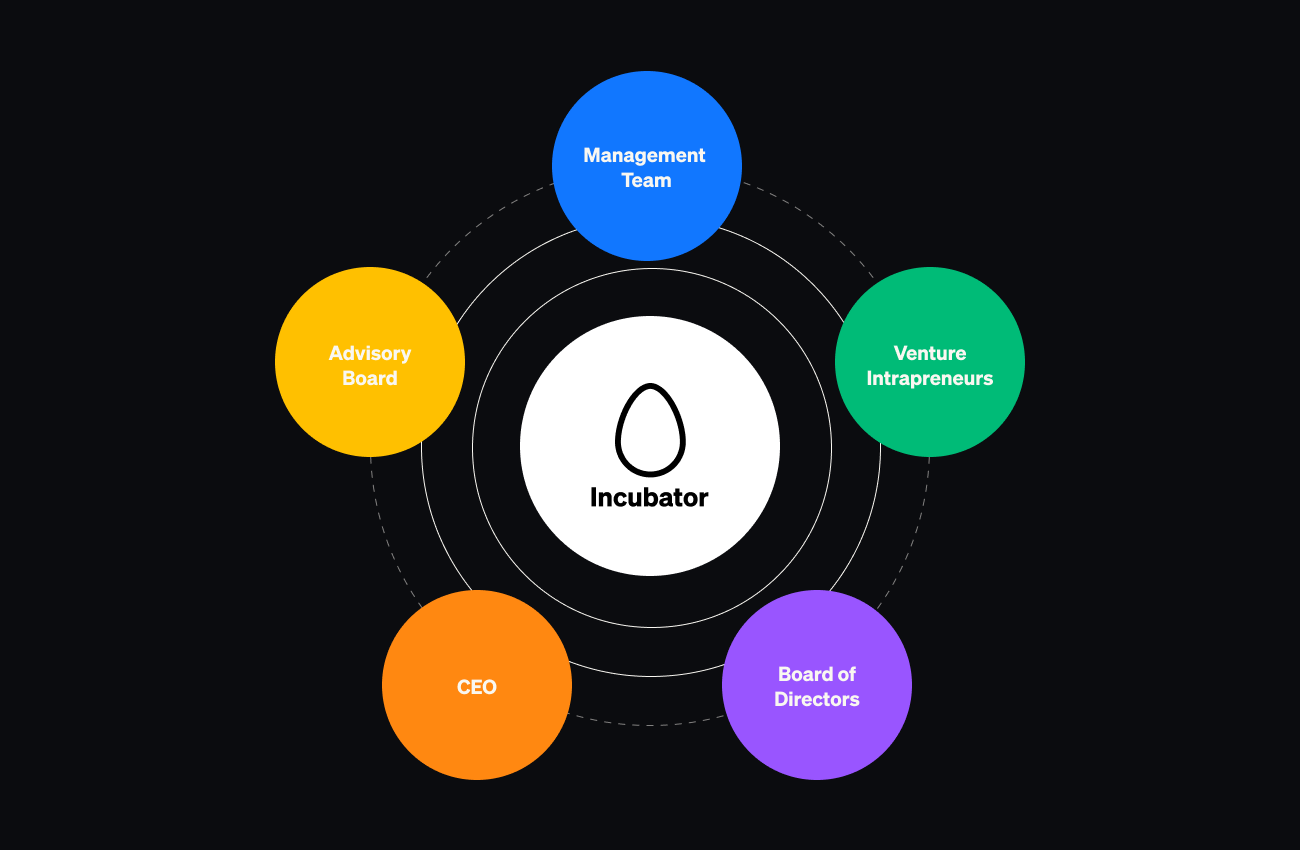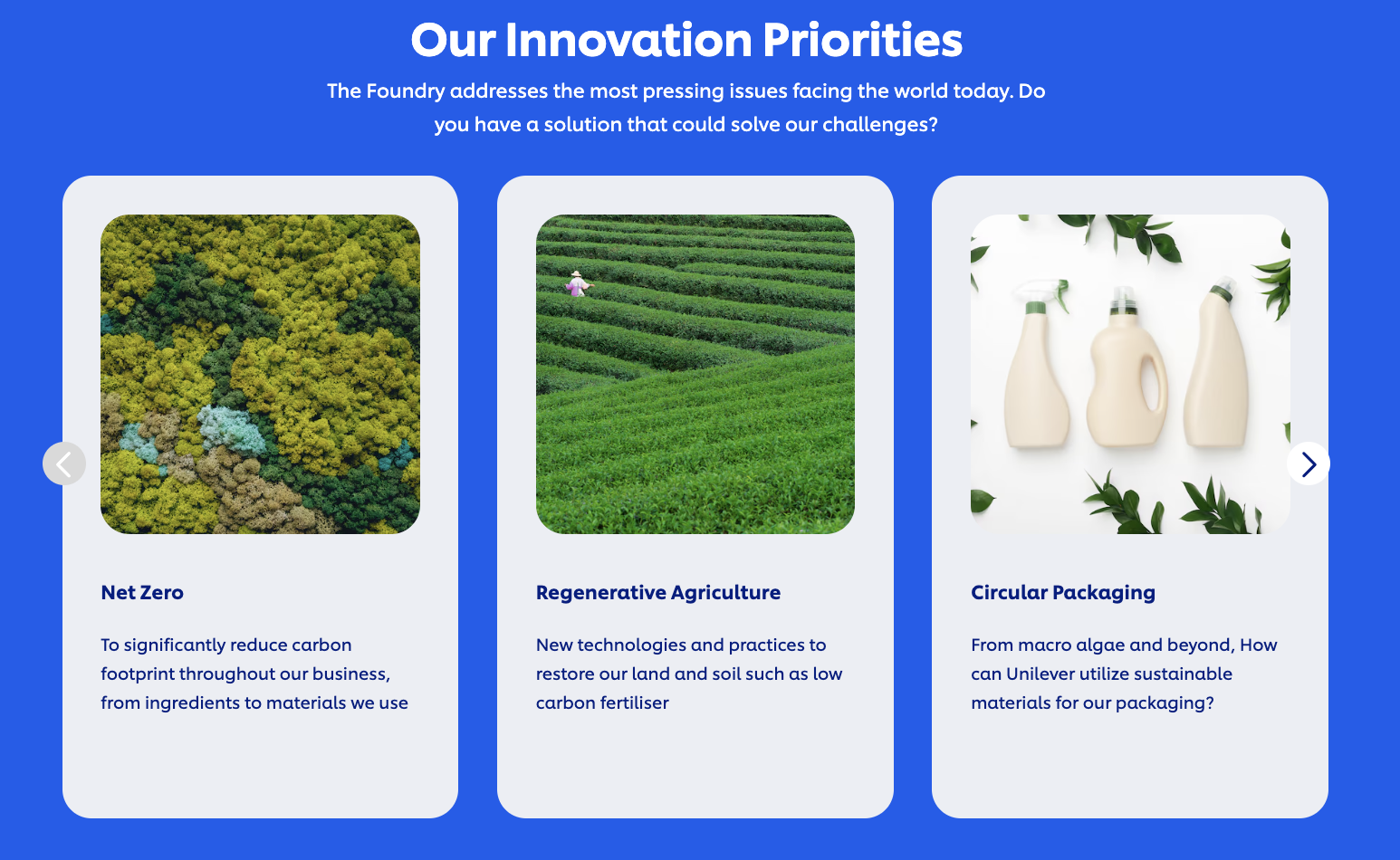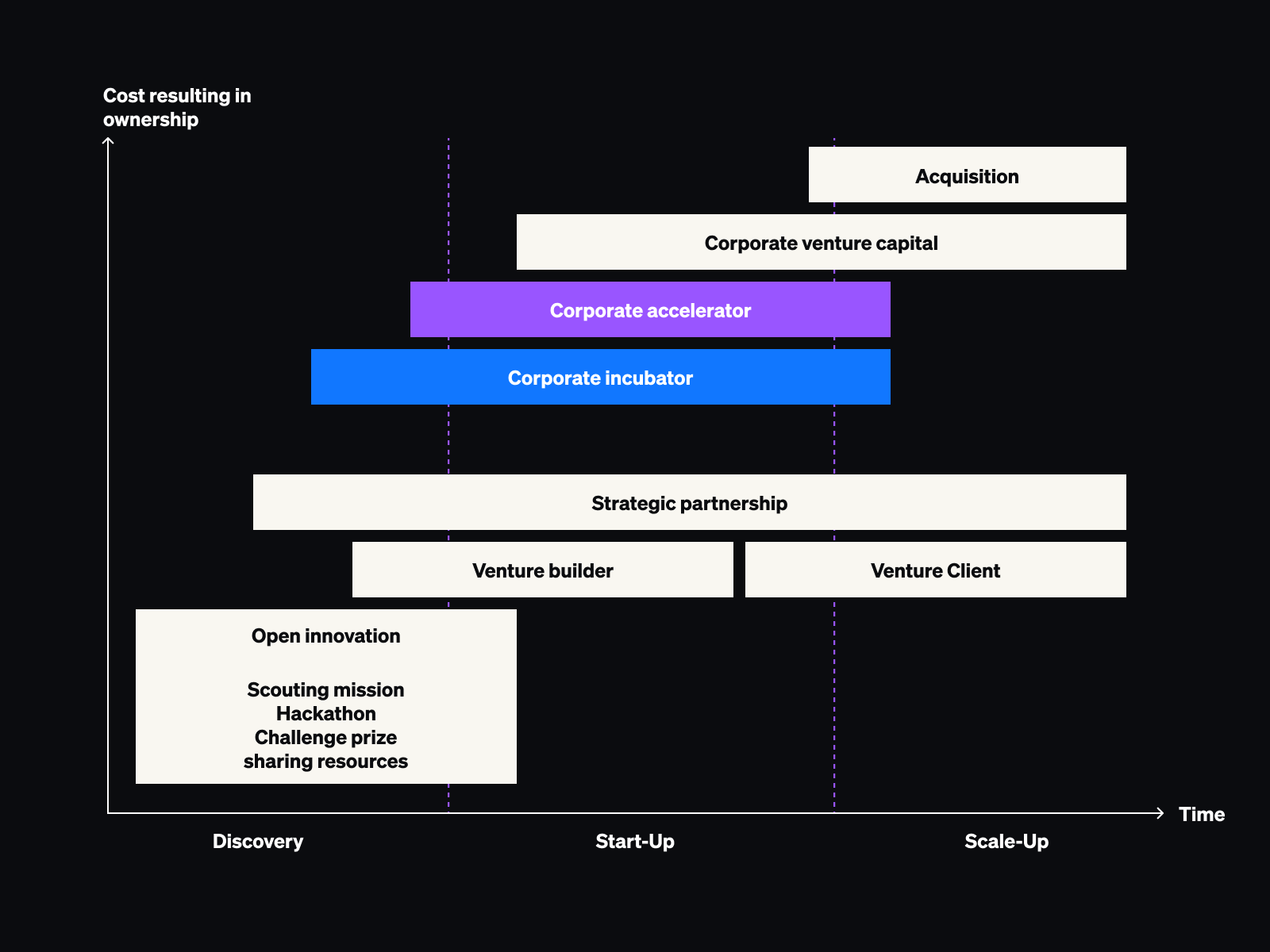Corporate incubators: An introduction
Over the years, corporate incubators have emerged as a proven and highly effective way to leverage corporate assets, explore new growth areas, fuel innovation, and foster an entrepreneurial mindset. Global enterprises like AstraZeneca, BASF and Volvo have already set up their own incubators with stellar results.
Their ultimate goal? To future-proof their businesses, identify new growth opportunities, maintain a competitive edge and create essential new revenue streams.
To give you a better idea of how incubators work, we’ve created this comprehensive guide illustrating what an incubator is, the benefits of having one, and how they’re positioned in the broader corporate venturing landscape (along with some other handy resources and examples).
So, whether you’re thinking about building your own incubator, already mid-way through the process, or simply looking to update your current setup, the insights in this article are sure to help you through your journey.
What is a corporate incubator, and what does it do?

A corporate incubator is an independent business unit within a corporation that supports new ventures from concept development to a fully functioning business. They leverage a company’s corporate assets to support employees or external entrepreneurs by providing mentoring, networks, infrastructure, funding and other resources they need to develop new products, services, or business models.
Many corporations choose to start their corporate venturing journey by building their own corporate incubator. Each new startup that gets developed provides the parent company with a slew of benefits, including:
- Access to innovative new technologies, products and services
- Insights to improve their offerings or create new ones
- The chance to expand beyond their core business
- The opportunity to test new technologies or business models
- The ability to reach new audiences and tap into new markets
These newly minted startups can go on to become important revenue streams for their parent companies, enabling them to grow, compete with new market entrants and find disruptive solutions to traditional problems.
Business incubators vs corporate incubators: What’s the difference?
Both business incubators and corporate incubators aim to support startup growth; however, their fundamental structures, objectives, and operations differ significantly. Here’s a quick breakdown:

Business incubators can be run by non-profit or private organisations, government entities, or academic institutions. They generally accept a wide range of startups and provide basic support services like shared office space, administrative support, and networking opportunities. Their success metrics usually centre around factors like the number of successful startups launched, profit, jobs created, and economic impact on the local community.
Examples: Idea Lab, StartX, i.AI
Corporate incubators, by contrast, are strategically focused entities that operate with specific business objectives in mind. They leverage their parent company's resources, expertise, and market position to develop ventures that could potentially create value for the organisation. Their selection criteria are typically more stringent, focusing on startups that align with the corporation's industry, technology needs, or future market opportunities.
Examples: Lufthansa Innovation Hub, Leonard, hub:raum
Some of the key differences between these two types of incubators include:
Resources and support
- Business incubators provide mentorship, office space and basic resources, often through partnerships with local service providers.
- Corporate incubators offer industry-specific expertise, access to proprietary technology, established customer bases, and specialised facilities.
Strategic focus
- Business incubators cast a wider net, supporting diverse startups across multiple sectors, though some specialise in sectors like AI and tech.
- Corporate incubators focus on ventures that could benefit their parent company's strategic objectives, whether through direct integration, market insights, or potential acquisition opportunities.
Funding structure
- Business incubator funding can rely on private funds, investors, government grants, university funding, or membership fees.
- Corporate incubators are usually funded by their parent companies and often have access to corporate venture capital.
Now, let’s take a look at some of the key differences between incubators and venture capital.
Incubator vs venture capital: What’s the difference?
Incubators and venture capital (VC) are both valuable corporate venturing and innovation tools, but they serve different functions and operate at different stages of a startup's development.

Let’s take a closer look at some of the differentiating factors:
Venture stage
- Incubators typically work with startups at their earliest stages, often when there's just an idea or basic prototype. They help validate concepts and build their first minimum viable product (MVP).
- Venture capital firms usually invest in companies that have already demonstrated some traction, whether through early revenue, user growth, or market validation.
Primary value proposition
- Incubators provide support beyond just funding (e.g. mentorship, workspace, technical resources, and hands-on guidance). They help shape early-stage ideas into viable businesses.
- Venture capital firms primarily provide financial investment, along with strategic guidance and networking opportunities, but typically don't offer the same level of hands-on operational support as incubators.
ROI expectations
Venture capital firms are primarily focused on financial returns. They achieve this by investing in a portfolio of companies, expecting a few big winners to offset inevitable losses. On the other hand, incubators, especially corporate ones, often have broader success metrics beyond financial returns, including:
- Strategic alignment with corporate objectives
- Innovation transfer to the parent company
- Market insights and learning opportunities
- Talent development and retention
- New capability development
Involvement timeline
- Incubators work intensively with startups for a defined period, usually 1-2 years, providing hands-on support during the crucial early stages.
- Venture capital involvement typically extends over several years through multiple funding rounds, with a focus on strategic guidance rather than day-to-day operations.
3 types of incubator business model
Corporate incubators typically fall into three main categories, each serving different strategic objectives.

Let’s take a closer look at each model individually:
Internal incubator model
Internal Incubators focus on developing ideas from employees within the organisation. They operate like an internal startup factory, turning promising employee concepts into viable businesses while retaining talent and intellectual property.
Key characteristics include:
- Focus on employees and internal teams
- Funded directly through corporate budgets
- Returns measured through new product development and revenue generation
- Full IP ownership remains with the parent company
Examples of this type of corporate incubator include EDF Pulse Incubation and Merck’s Innospire.
External incubator model
External incubators partner with independent entrepreneurs and early-stage startups that align with the corporation's strategic interests. These programs often provide workspace, funding, and access to corporate resources in exchange for equity or first rights to new technologies.
Key characteristics include:
- Scouting startups from outside the organisation
- Revenue generation through equity stakes or licensing agreements
- Providing workspace, funding, and access to corporate resources
- Often includes first rights to new technologies or products
Examples of this type of incubator include BMW Startup Garage and Vodafone Power Lab.
Hybrid incubator model
This model combines both internal and external innovation approaches, creating a more complex but potentially more rewarding business model. It focuses on fostering collaboration between corporate teams and external startups.
Key characteristics include:
- Balancing internal innovation with external partnerships
- Multiple revenue streams, including equity, licensing, and direct commercialisation
- Creating synergies between internal teams and external startups
Examples of this type of model include Microsoft’s The Garage and TenneT’s PowerLab.
Each of these models generates value differently:
- Internal models focus on direct revenue generation through new product development
- External models often rely on equity appreciation and strategic partnerships
- Hybrid models combine multiple value streams, including product development, equity stakes, and strategic partnerships
Your choice of incubator business model should align with your company's strategic objectives, resources, and expected returns.
The 7 benefits of having a corporate incubator

When executed skillfully, corporate incubators are a great way to innovate and develop disruptive new ideas that might otherwise get scrapped in favour of everyday corporate demands.
They’re especially useful for companies that are having trouble competing due to rapidly changing technologies, an outdated business model or the arrival of newer players in the market. We’ve outlined our top seven benefits of having a corporate incubator below:
1. Corporate incubators help involve employees in the innovation process.
Incubators often rely on internal staff and intrapreneurs to provide mentoring, expertise and pitch concepts. The approach creates a sense of involvement among employees prompting them to bring game-changing ideas forward, test them and learn fast, unrestrained by corporate boundaries.
Example:
Capital One’s The Lab builds ventures that are paving the way for its future. Part of its goal is to accelerate the bank’s digital transformation by exploring cutting edge technologies.
It operates as a fully integrated part of Capital One, and most of its venture ideas come from employees, partners or hackathons, and have practical applications in the business. This means that employees get to create the ventures that will make their work more effective in many cases.
2. Corporate incubators lead to the discovery of new value propositions.
Each new venture developed within an incubator holds the promise of reaching a new market segment, turning into a new revenue stream or creating a value proposition that will pave the way for the future.
Example:
RBCx is helping the Royal Bank of Canada attract new clients with new tech solutions. They think, act and operate like a startup while exploring new ideas that cater to unmet consumer needs and help bank expand beyond its core business.
Some of it's focus areas include fintech, AI, data analytics, security and customer experience.
3. Corporate incubators use existing assets to increase profits.
Corporate incubators encourage the exploration of new opportunities and help companies leverage their expertise and know-how.
Example:
Wayra, Telefónica’s corporate incubator, leverages the company’s global telecommunications infrastructure and market reach to support startups in areas like IoT, AI, and cybersecurity.
By providing these ventures with access to Telefónica’s extensive network and customer base, Wayra helps them rapidly scale, generating new revenue streams, making the most of existing assets and fuelling innovation.
4. Corporate incubators help companies acquire new insights and gain a competitive edge.
Experimenting with new concepts, ideas and business models often leads to insights that help companies solve problems faster, streamline their operations and increase cost-effectiveness.
Example:
Bosch’s Grow is developing a portfolio of ventures that is enabling Bosch to expand its capabilities and explore disruptive business models in 4 key areas: Mobility Solutions, Industrial Technology, Consumer Goods, and Energy and Building Technology.

Through Grow, Bosch is expanding beyond its core business and gaining access to new technologies that can provide a potential advantage over competitors.
5. Corporate incubators foster a culture of innovation.
Incubators facilitate innovation by encouraging creativity, experimentation and learning by failing. They reward out-of-the-box thinking and enable an entrepreneurial spirit to resonate throughout the organisation.
Example:
Google’s Area 120 highlights this value by developing core business concepts from internal staff instead of external sources. The approach enables them to leverage the talent and know-how from within the company to create disruptive new products and services.
6. Corporate incubators provide access to new ideas, skill sets, and technologies.
When developing new ventures from scratch, companies often pick up many game-changing insights, skills and know-how.
Example:
Lufthansa Innovation Hub, for example, works to spearhead its parent company’s digital transformation. Each new venture they develop and test adds to their skills and expertise, enabling them to learn more about their target audience and how to use technology to heighten customer experience.
7. Corporate incubators help expand a company’s strategic vision.
Incubators enable companies to step outside their core business (and comfort zone) to explore new concepts that might have otherwise gone undiscovered.
Example:
Neosfer, the corporate incubator of Commerzbank, empowers the company to step outside its traditional banking focus and explore emerging technologies like blockchain, AI, and sustainable finance.
By incubating ventures aligned with future trends, Neosfer is helping Commerzbank future-proof its operations and compete in markets outside its core business.
2 winning corporate incubator examples
Companies across almost every industry are successfully using corporate incubators as a tool to drive innovation, identify new growth markets and create new revenue streams—each one adapting the strategy to fit their unique needs.
To give you a better idea of how incubation works in practice, here are two examples of incubators that are helping their parent companies thrive:
1. Unilever Foundry
Parent Company: Unilever
Headquarters: London, UK
Founded: 2014
Active in: Consumer Goods
Type of innovation: Core and adjacent
Activities: Incubation, acceleration and investments
Unilever Foundry is partnership-focused, acting as a brdiget to connect Unilever's business units with external innovators. One of the aspects that makes it unique is that it doesn't take equity or IP from startups, instead offering non-dilutive capital through pilots and co-development opportunities. To date, the Foundry has facilitated over 400 partnerships between Unilever's business groups and external startups, focusing on challenges like sustainability, AI implementation, and plastic waste reduction (just to name a few).

Here are just a few of the factors that make Unilever Foundry successful:
Corporate assets galore
Startups working with Unilever Foundry gain access to Unilever’s vast resources, including its global reach, distribution channels, and consumer insights, which are crucial for testing and expanding their solutions.
Balanced independence
While Unilever Foundry operates independently to encourage unique and innovative ideas, it remains connected to Unilever to harness its expertise and market presence effectively.
Open innovation
Unilever Foundry connects with the external innovation ecosystem, effectively bridging the gap between corporate objectives and innovative partners. Their strategy emphasises transparent communication, aligning the needs of both sides and employing established collaboration methods to ensure the success of these partnerships.
Constant validation
Unilever Foundry continuously assesses the impact and viability of the projects within its ecosystem. This process ensures that only the most promising and strategically aligned innovations move forward, maximising the potential for success, impact and profitability.
2. Basf’s Chemovator
Parent Company: BASF
Headquarters: Mannheim, Germany
Founded: 2018
Activities: Incubation
Managing Director: Markus Bold
Active in: Chemistry
Chemovator provides a protected space for innovation teams to turn “bold ideas into thriving businesses”. They test early-stage concepts and explore unconventional growth opportunities in the chemicals space with a broader focus on areas like construction, transportation, energy and more. The result? A pipeline of low-risk, investable ventures for BASF to internalise or turn into spin-off companies.

Here are just a few of the factors that make Chemovator successful:
A protected environment
Corporate processes and bureaucracy often impede the innovative process, blocking disruptive ideas from getting developed and slowing the process with too many regulations. Chemovator provides intrapreneurs and external startups with a protected space to develop their ideas free of typical corporate setbacks.
Corporate assets
New ventures developed at Chemovator enable BASF to effectively leverage corporate assets like partnerships, networks, infrastructure, industry know-how and funding.
Intrapreneur empowerment
Employees are one of the most valuable assets a corporation can have. By empowering its employees to develop projects they’re passionate about, BASF is engaging its staff and making the most of their talent, expertise and industry knowledge.
An effective support structure
Chemovator provides its venture teams with a support system of:
- External entrepreneurs with proven experience
- An internal core team with years of BASF experience
This combines knowledge and expertise from both in and outside the parent company, culminating in a venture program with the best of both worlds.
It’s independent but not disconnected
Being independent but remaining connected enough to complement the parent company is crucial to the success of any corporate incubator.
Check out this article for more inspiring corporate incubator examples.
How do incubators fit into the greater corporate venturing landscape?

The greater corporate venturing landscape has various innovation tools designed to help companies fuel new growth. Some of these tools include (but are not limited to):
Corporate Venture Capital (CVC)
When corporations use direct equity investments to target startups of strategic interest.
Example:
Founded in 1991, Intel Capital is one of the longest-running and most successful corporate venture capital operations. Some of its success metrics include:
- Over 690 portfolio company exits through IPOs or acquisitions
- Investments in over 57 countries
- Notable investments include Broadcom, VMware, and DocuSign
Mergers & Acquisitions (M&A)
When established firms purchase startups and their commercial-ready products in order to access new technologies or markets.
Example:
In 2018, Amazon acquired online pharmaceutical company PillPack as part of its effort to break into the healthcare industry.
The move provided Amazon with a built-in customer base, a proven business model and the technology to compete with the likes of Walgreens and CVS.
Venture development studios
A venture development studio, startup studio, company builder, or venture builder is a structure that creates startups based on shared resources and a multidisciplinary team. It provides what is known as “Startup as a Service”.
Example:
Bundl is an excellent example of how a venture development studio works, teaming up with corporates to create new ventures and discover new markets.
Check out our cases page to learn more about how we build corporate ventures.
Corporate Accelerators
Corporate accelerators offer highly structured programs that typically last about three months.
These programs provide startups with the facilities, resources, and expertise needed to speed up their product development and prove themselves on the market.
Example:
Wells Fargo Startup Accelerator has a six-month program to help young startups test, prove, and grow their concept.
Financial services startups that make it into the program gain access to the bank’s industry expertise, networks and mentors - not to mention a possible investment of up to $1,000,000.
Now that we've covered the basics, let's take a closer at some of the key differences between incubators and accelerators.
How is an incubator different from an accelerator?
Although some people use these terms interchangeably, incubators operate quite differently than accelerators:
Corporate Incubator
Incubators nurture disruptive ideas to help them transform into an independent company with a solid business model.
Corporate accelerator
Accelerators are the next step in the process, helping young companies expedite their growth and scale their existing business models.
Here are a few other key differences:
Programming
- Incubator programs tend to be flexible and on-demand.
- Accelerator programs are fixed and highly structured.
Duration
- The incubation process lasts 1 to 3 years.
- The acceleration process lasts only 3 to 6 months.
Return
- Incubators usually have full ownership of the venture.
- Accelerators tend to establish partnerships or arrange for equity.
How to start a startup incubator
Now that you know a bit more about corporate incubation, you’re probably wondering what your own corporate incubator would look like, what its goals would be and how you can get started.
The first thing you need to do is map out a solid framework you can use to:
- Shape your corporate incubator
- Use as a basis for strategic decisions later on
During this step, you'll be:
- Finding the strategic value of your incubator and setting the right scope for the future.
- Making crucial decisions for its development and success.
- Developing a clear framework, you can use as the basis of your stakeholder pitch.
The exercise will help solidify your incubator’s long term mission, goals and positioning.
How to ensure the success of your corporate incubator

We’ve already outlined some of the key benefits of having a corporate incubator, but what does it take to ensure its success? To answer that question, we’ve outlined our 10 step strategy below:
Step 1: Establish a clear purpose.
Start by envisioning what your end goal is and why your company needs an incubator. Once that’s done, figure out what the scope of your incubator will be (e.g. What expertise will your incubator have?).
Based on that, you’ll have a pretty good idea of what your incubator’s direction will be and the resources you’ll need to get started.
Step 2: Define the range of your corporate incubator.
It’s important to have a clear idea of how far you want to branch out from your core business. A good way to start is by figuring out the type of innovation you want to achieve (e.g. radical innovation? adjacent innovation? core Innovation?).
Step 3: Decide how to build your team.
Once you have a good idea of what your new incubator’s product or service will be, the next step is to figure out the type of expertise you’ll need to make it a reality.
Depending on what your new offering is, you might need to bring in experts from outside your company. If that’s the case, you’ll have to choose between building a new team with only external experts or a mix that includes people from within your corporation as well.
Step 4: Define the potential additional activities of your incubator.
Find new tools to compliment your incubator activities, e.g.:
- Startup investment: Investing in startups within the focus of the incubator.
- Mergers & acquisitions: Take over existing startups within the focus of the incubator.
- Startup acceleration: Inviting startups to join an added acceleration program.
Step 5: Focus on the right criteria to select your venture ideas.
Focusing on the right criteria will help you make well-founded decisions when refining your venture ideas later on. Work on defining things like your solution fit, company strategy fit, market validation and your business case.
Covering your bases early on will significantly increase your chances of success as you move through your incubator program.
Step 6: Set up a timeline and milestones for your incubator program.
Make sure you have detailed outlines illustrating the duration, process flows, milestones and deliverables of your incubator program. Taking this step will help keep you focused on your goals and avoid unnecessary delays.
Step 7: Allocate your resources wisely.
New ventures need resources to get up and running, and it takes a lot more than just money to make it all happen. Make careful decisions about which resources you can use to strengthen your new venture.
Having a clear idea of what resources your incubator program needs will help you quickly and efficiently reach your scale phase.
Step 8: Motivate your team with the right incentives.
Setting up an effective incentives program is a crucial factor in the success of any new venture, so put careful thought into the type of incentive programs you’ll use.
Taking this measure early on will ensure that your team is adequately motivated to build your next breakthrough product or service.
Step 9: Position your incubator strategically within the corporate structure.
Positioning your incubator close to the executive level of your company will help you bypass long chains of command and expedite your approvals.
Remember, no matter how brilliant your business ideas are, your venture runs the risk of being delayed or even phased out if you don’t have the right positioning, connections and internal support.
Step 10: Plan past the incubation phase.
Decide on what happens when your venture is incubated and ready to scale.
Having a long term plan will keep you focused and working towards your pre-established goals, increasing the chance that your business unit will become a prosperous company when the time comes to scale.
Find out more about the 10 key steps in this handy report.
Key insights from corporate incubator leads
As a venture development firm, we often have the privilege of speaking to some of the world’s leading corporate innovators about the work they do and what it takes to succeed in that space. Some of our most recent interviews included Richard Faas, former CIO of the Legal Tech Studio (currently COO Faas Psychologie) and Lisa Besserman, former Head of Program at Indeed’s Global Incubator (currently Managing Director at J.P Morgan Chase). Here are some of the insights they shared with us:
Alignment with corporate leadership is crucial.
Corporate leaders and stakeholders play a huge role in determining the incubator’s greater mission, its growth goals, and they serve as key advisors and influencers. Their involvement and support are critical to the success of your incubator.
Use the talent that’s available to you.
Collaborate with different areas in the company to create a multidisciplinary approach to your projects.
Democratise your key learnings for real impact.
Make a conscious effort to share your learnings through events like Lisa’s Learning Initiative. An event created to share Global Incubator’s knowledge throughout the company.
Build stakeholder trust with short-term projects.
Adding short-term projects to the agenda enables you to produce results quickly and gain the support you need for bigger projects.
Is corporate incubation right for you?
When executed skillfully, incubators are a great way to innovate and develop disruptive new ideas. They’re especially useful for companies that are having trouble competing due to rapidly changing technologies, outdated business models or the arrival of new players in the market.
If you recognise any of these traits in your company, it might be a good idea to take a closer look at investing in your own corporate incubator.
For more inspiring corporate incubator examples, check out the 60 corporate incubators report.
____
Want to know more about how to set up your own corporate incubator? We can help you create an incubation strategy that meets your unique needs.







